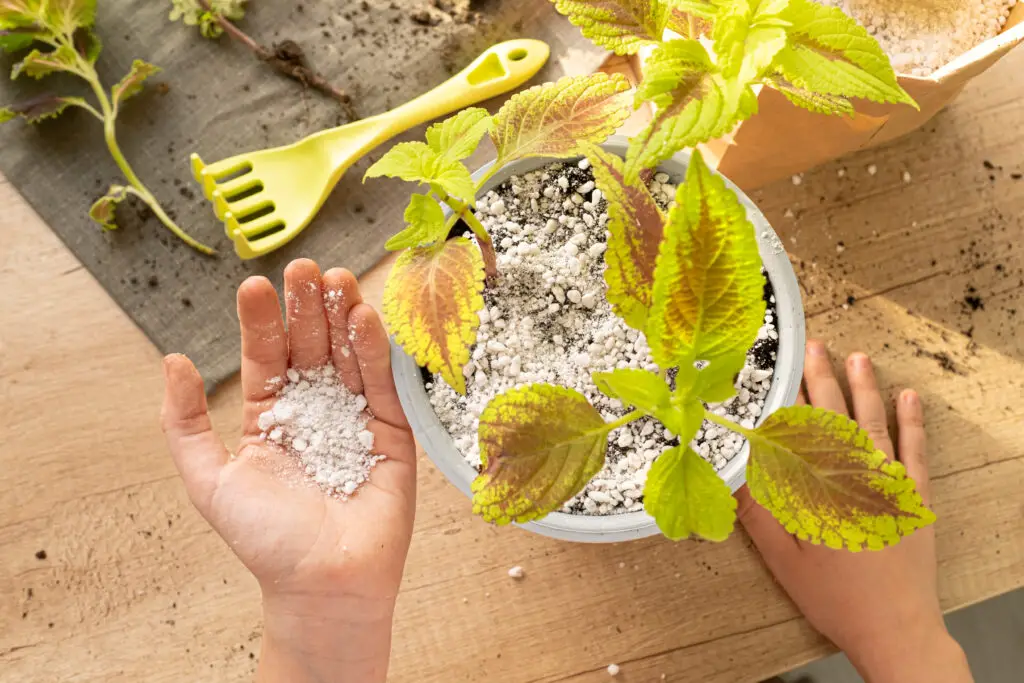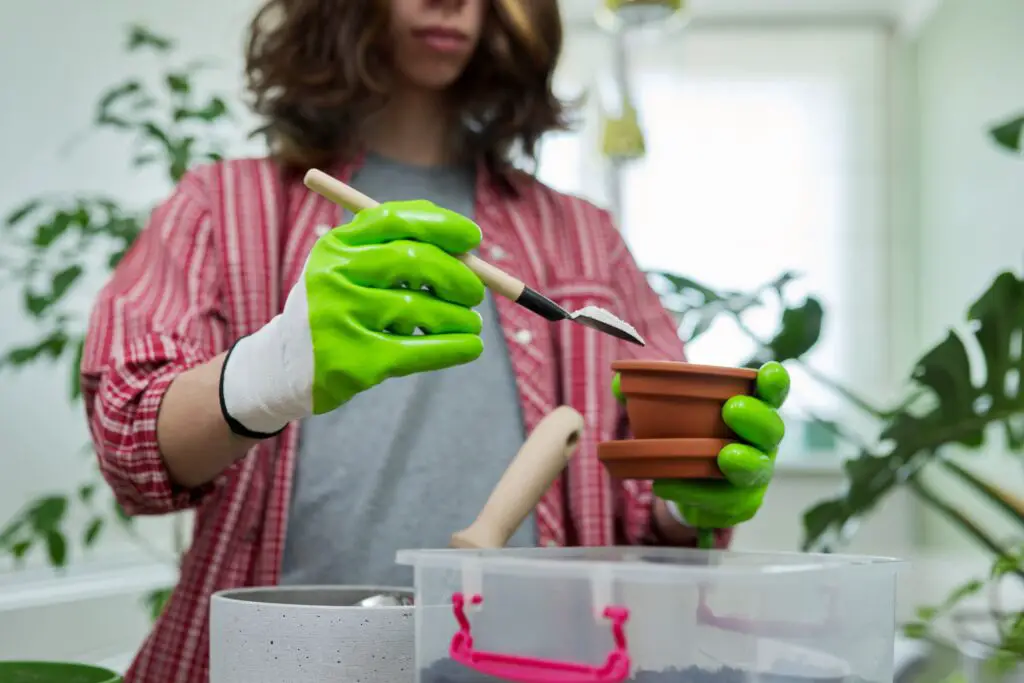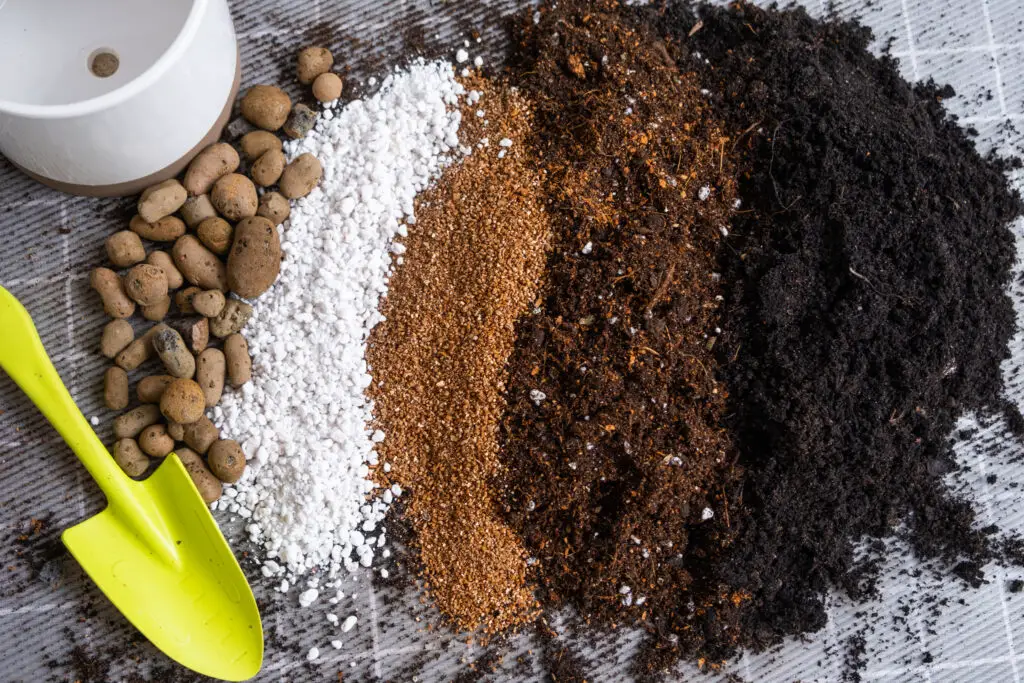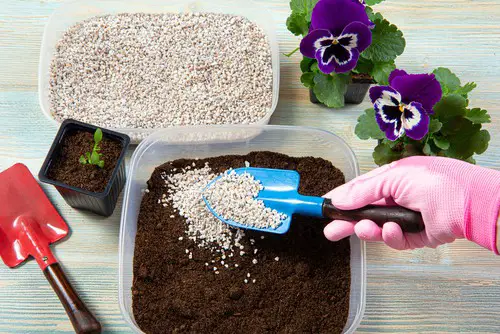Perlite is a popular soil amendment used by gardeners and horticulturists to improve soil drainage and aeration. It is a type of volcanic glass that is heated to high temperatures to expand into a lightweight, sterile, and porous material.
Perlite is commonly used in potting mixes, hydroponic systems, and soilless growing media. However, some gardeners have noticed their perlite turning brown and are wondering why this is happening.
When perlite turns brown, it is usually due to soil particles embedding themselves into the tiny holes of the perlite. This discoloration is purely cosmetic and does not harm the plants.
Nonetheless, gardeners may be concerned about the appearance of their perlite and may want to know how to prevent or treat brown perlite. In this article, we will explore the reasons why perlite turns brown, its effects on plant growth, and how to prevent and treat this issue.
Key Takeaways
- Perlite is a popular soil amendment used to improve soil drainage and aeration.
- Perlite turns brown due to soil particles embedding themselves into the tiny holes of the perlite, which is purely cosmetic and does not harm the plants.
- Gardeners can prevent or treat brown perlite by using clean perlite, washing the perlite with diluted bleach, or using a different soil amendment altogether.
Check out these other posts:
- Peperomia Leaves Turning Brown and Falling Off:
- Peperomia Leaves Turning Brown:
- Pencil Holly Turning Brown
Understanding Perlite

Perlite is a naturally occurring volcanic glass that is mined and processed into a lightweight and porous material. It is commonly used as a soil amendment for plants due to its excellent drainage and aeration properties. Perlite is also sterile, meaning it does not contain any harmful pathogens or weed seeds.
When perlite is exposed to moisture, it expands and becomes porous, creating air pockets within the soil. These air pockets allow plant roots to access oxygen, which is essential for healthy growth. Perlite also helps prevent waterlogging and root rot by allowing excess water to drain away from the plant’s roots.
However, perlite can sometimes turn brown, which can be concerning for plant growers. This discoloration is usually caused by soil particles embedding themselves into the tiny holes of the perlite. The discoloration is purely cosmetic and does not harm the plant in any way.
To prevent perlite from turning brown, it is recommended to rinse it thoroughly before use. This will remove any loose particles and reduce the likelihood of discoloration. Additionally, it is important to avoid overwatering plants, as this can lead to soil saturation and increased discoloration of the perlite.
Why Perlite Turns Brown
Perlite is a popular soil amendment for many gardeners and growers due to its ability to improve soil drainage and aeration. However, perlite can turn brown, which can be concerning for some gardeners. In this section, we will discuss the reasons why perlite turns brown.
Water Quality
One of the reasons why perlite turns brown is due to the water quality. If the water used to water the plants contains high levels of minerals or salts, it can cause the perlite to turn brown.
This is especially true if the water is hard water, which contains high levels of calcium and magnesium. Using distilled or rainwater can help prevent perlite from turning brown.
Excess Nutrients
Another reason why perlite turns brown is due to excess nutrients in the soil. When there are too many nutrients in the soil, it can cause algae to grow, which can stain the perlite. This is especially true if the soil contains vermicompost or peat, which can release excess nutrients into the soil.
High Humidity
High humidity can also cause perlite to turn brown. When perlite is wet for extended periods of time, it can promote the growth of harmful bacteria and fungi, which can cause discoloration. To prevent this, it is important to allow the perlite to dry out between waterings and to avoid overwatering the plants.
To prevent perlite from turning brown, gardeners can use a diluted bleach solution to wash and soak the perlite for at least 20 minutes. This can help remove any discoloration caused by algae or other contaminants. Another option is to use hydrogen peroxide, which can also help remove any stains or discoloration.
Effects on Plant Growth

Perlite is a popular growing medium for plants due to its ability to improve aeration and drainage in soil. However, when perlite turns brown, it can have negative effects on plant growth.
One effect of brown perlite on plant growth is reduced oxygen uptake. Perlite that has turned brown may compact and become waterlogged, reducing the amount of oxygen available to plant roots. This can lead to root rot and stunted growth.
Brown perlite can also affect the pH of the soil mix, which can impact plant growth. Perlite has a neutral pH, but when it turns brown, it may become acidic or alkaline depending on the source of the discoloration. This can affect the availability of nutrients and cause yellowing or browning of leaves.
In addition, brown perlite may stain the soil mix, which can be unsightly and may attract pests such as knats. This can also affect the pH of the soil mix and lead to nutrient deficiencies.
To prevent brown perlite from affecting plant growth, it is important to use high-quality perlite and to monitor the soil mix for signs of compaction or waterlogging. Adding clay balls or pumice to the soil mix can also improve drainage and prevent compaction.
It is also important to provide adequate light, nutrients, and care for plants growing in perlite. Using a balanced fertilizer and providing filtered or distilled water can help prevent nutrient deficiencies and reduce the risk of rust or other discoloration.
Preventing and Treating Brown Perlite
When perlite turns brown, it can be unsightly and affect the aesthetic value of indoor gardening. Brown perlite is usually caused by soil staining, excess nutrients, or algae growth due to high humidity. However, it can also be a sign of harmful substances in the water or growing medium.
To prevent brown perlite, it is important to use high-quality water. Tap water can contain minerals and salts that can stain perlite. Using distilled or filtered water can help prevent discoloration.
Additionally, perlite can be rinsed with a diluted bleach solution to remove any algae growth or staining. It is important to rinse the perlite thoroughly after using bleach to prevent harm to plants.
To treat brown perlite, the cause of the discoloration must be diagnosed. If the cause is excess nutrients, perlite can be washed with water to remove any buildup. If the cause is soil staining, perlite can be replaced with a fresh batch. If the cause is algae growth, perlite can be treated with hydrogen peroxide or a diluted bleach solution.
Proper care of perlite can also prevent brown discoloration. Perlite should be kept wet but not saturated, as excess moisture can lead to algae growth.
Additionally, perlite should be mixed with peat moss or vermicompost to improve drainage and oxygen uptake. Using clay balls or pumice in the growing medium can also improve drainage and prevent soil staining.
In hydroponics, perlite can be used as a growing medium. However, it is important to monitor water quality and temperature to prevent brown discoloration. Using a 400W MH light can also prevent algae growth.
Discussion and Final Thoughts

Perlite turning brown can be a common issue for plant growers, both indoors and outdoors. While it may not necessarily harm the plant, it can be unsightly and affect the aesthetic value of the plant. The discoloration can occur due to a variety of reasons, including staining, algae growth, and excess nutrients in the soil mix.
One possible reason for perlite turning brown is the quality of water used for watering the plant. Tap water may contain minerals like calcium and magnesium, which can cause staining.
Using distilled or filtered water can help avoid this issue. Additionally, high humidity levels can cause the perlite to turn brown due to the growth of algae or fungus. Proper ventilation and air circulation can help prevent this.
Another possible cause of brown perlite is the presence of excess nutrients in the soil mix. Over-fertilization can lead to salt buildup in the soil, which can cause the perlite to turn brown.
Using a balanced fertilizer and following the recommended dosage can help avoid this issue. It is also important to ensure proper drainage and avoid overwatering, as excess water can lead to the buildup of harmful salts in the soil.
In indoor gardening, the use of grow lights can also affect the color of perlite. A 400W MH light can cause the perlite to turn orange due to the high temperature of the light. Using grow lights with lower wattage or LED lights can help avoid this issue.
Treating brown perlite depends on the underlying cause. If the issue is due to staining or algae growth, a diluted bleach solution can be used to treat the perlite.
If the issue is due to excess nutrients in the soil mix, flushing the soil with water can help remove the buildup of salts. Adding vermicompost or dolomite lime to the soil mix can also help balance the pH and nutrient levels.
Frequently Asked Questions
Why is my plant’s perlite changing color?
Perlite turns brown due to a variety of reasons, including soil mixing, water-clogging, and high humidity. Dirt particles embed themselves into the tiny holes of perlite, causing it to stain and change color.
Understanding why your perlite is turning brown is vital to understand what you should do about it.
What causes perlite to turn brown?
Perlite turns brown due to soil mixing, water-clogging, and high humidity. When dirt particles embed themselves into the tiny holes of perlite, it causes it to stain and change color. Exposure to sunlight and outdoor conditions can also cause perlite to turn brown.
Is brown perlite a sign of overwatering?
Brown perlite can be a sign of overwatering, but it can also be caused by soil mixing and exposure to outdoor conditions. Overwatering can lead to water-clogging and high humidity, which can cause perlite to turn brown. However, it is not always a sign of overwatering.
How can I prevent perlite from turning brown?
To prevent perlite from turning brown, it is essential to avoid overwatering and ensure that the soil is well-draining. Using a pot with drainage holes can help prevent water-clogging and high humidity, which can cause perlite to turn brown.
Additionally, keeping the perlite covered can help prevent exposure to outdoor conditions.
Can perlite be reused after turning brown?
Perlite can be reused after turning brown, but it is essential to ensure that it is safe to reuse. Washing and soaking discolored perlite with diluted bleach for at least 20 minutes can help make it safe to reuse.
However, it is recommended to replace perlite if it has been used for an extended period or if it has become heavily discolored.
What is the effect of brown perlite on plant growth?
Brown perlite does not have a significant effect on plant growth as long as it is safe to use. However, heavily discolored perlite may indicate that it has been used for an extended period or exposed to unfavorable conditions, which may affect its ability to provide adequate drainage and aeration to the plant’s roots.

Hey, I’m Lisa and I’ve been an avid gardener for over 30 years. I love writing, talking and living in the garden! Feel free to connect with me on my socials below


